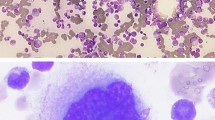Summary
The effect of an immunotherapy with Corynebacterium parvum on the blood coagulation system was investigated in a randomized trial of 18 patients with metastatic breast cancer. All patients received cytostatic therapy. Additionally, C. parvum was given intravenously on day 15 of the cytostatic cycle (group I) or on day 1 (group II) or not at all (group III). Fibrinopeptide A increased within 2 h after intravenous administration of C. parvum in groups I and II and normalized after 24 h (p<0.05). Platelet counts decreased continuously in all treatment groups (p<0.05). Prothrombin time, fibrinogen concentration, factor VIII:C and factor VIIIR:Ag were not affected. The fibrinolytic activity showed a slight but not statistically significant increase after intravenous administration of C. parvum. The data suggest that plasma hypercoagulability is induced or enhanced in man even after small intravenous doses of C. parvum.
Similar content being viewed by others
References
Bouna BN, Starkenburg AE (1974) Dilution of haemophilic plasma used as a reagent in the determination of anti-haemophilic factor A (factor VIII). Haemostasis 3: 94
Cederholm-Williams FA, King A, Allington MC, Gill PJ, Sharp AA, Britton BJ (1978) Coagulation and fibrinolysis during the infusion of Corynebacterium parvum in man. Br J Cancer 37: 1074
Chew EC, Wallace AC (1976) Demonstration of fibrin in early stages of experimental metastasis. Cancer Res 36: 1903
Donati MB, Poggi A (1980) Malignancy and haemostasis. Br J Haematol 44: 1973
Godal HC, Abildgaard V (1966) Gelation of soluble fibrin in plasma by ethanol. Scand J Haematol 3: 342
Harenberg J, Hepp G, Schmidt-Gayk H (1979) Fibrinopeptide A in human plasma — Evaluation of a new radioimmunoassay technique on microliter-plates. Thromb Res 15: 513
Harenberg J, Weber E, Spohr U, Mörl H (1980) Is the diurnal increase of fibrinolytic activity influenced by alpha- or beta-adrenergic blockade? Blut 41: 455
Harenberg J, Zimmermann R, Weber E (1981) Fibrinopeptide A in acute coronary insufficiency. Lancet I: 96
Harenberg J, Haas R, Zimmermann R (1981) Measurement of Fibrinopeptide A in patients treated with phenprocoumon. Thromb Haemost 45: 282
Israël L, Edelstein R (1977) Personal experience with Corynebacterium parvum in human cancers. World J Surg 1: 585
Jones PDE, Sadler TE, Castro JE (1977) Effect of Corynebacterium parvum on peripheral blood platelets. Br J Cancer 36: 777
Laurell CB (1966) Quantitative estimation of proteins by electrophoresis in agarose gel containing antibodies. Anal Biochem 15: 45
Lyman GH, Bettigole RE, Robson E, Ambrus JL, Urban H (1978) Fibrinogen kinetics in patients with neoplastic disease. Cancer 41: 1113
Mayr AC, Senn HJ, Gallmeier WM, Bruntsch U, Becher R, Drings P, Fritze D, Kaufmann M, Queißer W, Kempgens U (1979) Ardiamycin-Combination-Chemotherapy with or without immune stimulation of Corynebacterium parvum in metastasizing carcinoma of the breast. Dtsch Med Wochenschr 104: 1739
Mitcheson HD, Hilgard P, Craw AA, Castro JE (1980) Mechanism of C. parvum-induced coagulopathy in mice. Br J Cancer 41: 117
Nossel HL, Yudelman I, Canfield RE, Butler VP, Spanondis K, Wilner GD, Qureshi GD (1974) Measurement of fibrinopeptide A in human blood. J Clin Invest 54: 43
Peuscher FW, Cleton FJ, Armstrong L, Stoepman-van Dalen E, von Mourik JA, van Aken WG (1980) Significance of plasma fibrinopeptide A in patients with malignancy. J Lab Clin Med 96: 5
Schwarz D, Andrassy K, Egbring R, Albrecht H, Harenberg J, Koderisch J, Drings P (1980) Hypercoagulability in patients with malignancy. Blut 40: 88
Warren BA (1973) Tumor metastasis and thrombosis. Thromb Diath Haemorrh [Suppl] 59: 139
Yudelman IM, Nossel HL, Kaplan KJ, Hirsh J (1978) Plasma fibrinopeptide A levels in symptomatic venous thromboembolism. Blood 51: 1189
Zimmermann R, Mörl H, Harenberg J (1979) Urokinase treatment of phlegmasia coerulea dolens. Dtsch Med Wochenschr 104: 1563
Author information
Authors and Affiliations
Additional information
Dedicated to Prof. Dr. Dr. h. c. mult. G. Schettler on his 65th birthday
Supported by grants from the “Deutsche Forschungsgemeinschaft”
Rights and permissions
About this article
Cite this article
Harenberg, J., Baumgärtner, A., Fritze, D. et al. Hypercoagulability after immunotherapy with corynebacterium parvum in man. Blut 44, 241–247 (1982). https://doi.org/10.1007/BF00319910
Received:
Accepted:
Issue Date:
DOI: https://doi.org/10.1007/BF00319910




